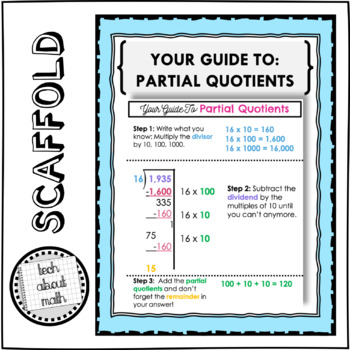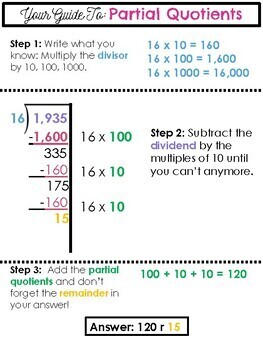Partial Quotients Step-By-Step Guide for Students
- PDF
Description
Using the partial quotients strategy is simple with this easy-to-follow study guide. This is a quick and easy guide for students so they can independently solve division problems! These can be used as you teach a topic for students who need step-by-step instructions. This can also be used as an anchor chart, poster, or a guide for parents. My students' parents love when I send these home so that they can help with the material.
This common core resource contains 20 task cards for operations with decimals. The standard that is addressed with these task cards is 5.NBT.6
Find whole-number quotients of whole numbers with up to four-digit dividends and two-digit divisors, using strategies based on place value, the properties of operations, and/or the relationship between multiplication and division. Illustrate and explain the calculation by using equations, rectangular arrays, and/or area models.
Wondering where to use this study guide? Check out this blog post.
Looking for the paper version of my GO Math aligned study guides? Click here!
---
Please consider leaving feedback for this product! It means so much to me, and it helps you earn FREE products! For every review you leave, you earn 1 credit point toward a future purchase. Go to "My Purchases" to leave a review & thank you in advance!
If you hit the green FOLLOW ME button, you will get:
-Updates when new products are released
-Notifications when I have a sale
Connect with me:
Check out my blog to see the latest tips and tricks on integrating tech into your classroom! (and grab some freebies while you’re there!)
For teacher tech systems, digital student engagement, and time-saving tech hacks:
If you want to see pictures of my adorable dog and find some awesome tech tips:
Watch quick tech tutorials on my YouTube channel:
Subscribe to my YouTube channel
Questions? E-mail me at alexandra@techaboutmath.com




